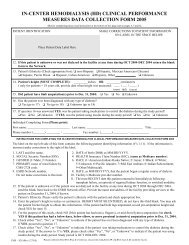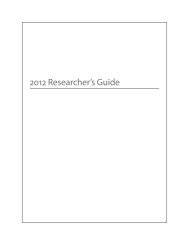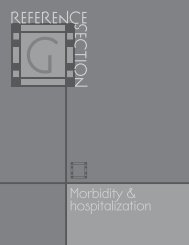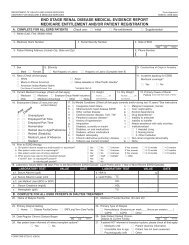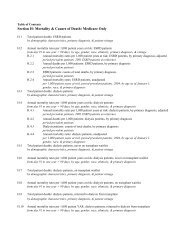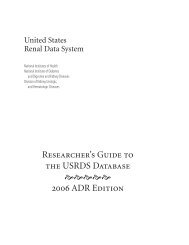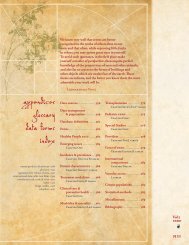4. Patient Characteristics from CMS Medical Evidence Form
4. Patient Characteristics from CMS Medical Evidence Form
4. Patient Characteristics from CMS Medical Evidence Form
You also want an ePaper? Increase the reach of your titles
YUMPU automatically turns print PDFs into web optimized ePapers that Google loves.
<strong>Patient</strong> <strong>Characteristics</strong> <strong>from</strong> HCFA <strong>Medical</strong> <strong>Evidence</strong> <strong>Form</strong><br />
USRDS 1999 Annual Data Report<br />
3.5<br />
Serum Albumin and Body Mass Index (BMI)<br />
for New ESRD <strong>Patient</strong>s, 1995-98*<br />
Average Serum Albumin (g/dl) Average BMI (kg/m 2 )<br />
27<br />
3.4<br />
3.3<br />
3.2<br />
3.25<br />
3.22<br />
3.20<br />
3.19<br />
25.39<br />
25.52<br />
25.67<br />
26.05<br />
26<br />
25<br />
3.1<br />
3.0<br />
24<br />
1995 1996 1997 1998 1995 1996 1997 1998<br />
IV -11<br />
*Reported on HCFA <strong>Medical</strong> <strong>Evidence</strong> <strong>Form</strong>; 1998 data are through June USRDS 1999<br />
Figure IV-11<br />
Average serum albumin (g/dl) and body mass index (BMI, kg/m 2 ) by year for new ESRD patients as reported<br />
on the HCFA <strong>Medical</strong> <strong>Evidence</strong> <strong>Form</strong>, 1995 through June of 1998. BMI is computed as weight/(height) 2 .<br />
Source: Reference Table L.21.<br />
In 1998, the mean serum albumin before first<br />
chronic dialysis was reported to be 3.2 g/dl (Figure<br />
IV-11). This is far below the normal range of <strong>4.</strong>0-5.0<br />
g/dl. It highlights the fact that, on average, new<br />
patients to dialysis are considered “malnourished”,<br />
which maybe related to many pre-ESRD factors and<br />
the timing of dialysis initiation. As serum albumin is<br />
an important predictor of mortality, both in the short<br />
term and for up to 5 years following dialysis<br />
initiation (Leavey), our attention should be focused<br />
on improving pre-ESRD care and on interventions<br />
that might improve nutritional status. Similarly, in<br />
1998 the average BMI was reported to be 26 kg/m²<br />
(Figure IV-11). This measure has also been shown to<br />
be an independent predictor of mortality among<br />
dialysis patients (Leavey).<br />
Reporting of Comorbid Conditions<br />
Among New Dialysis <strong>Patient</strong>s<br />
It is recognized that inadequate data recording<br />
and the omission of pertinent patient characteristics<br />
may affect the validity of the data collected. The<br />
potential for poor recording of patient characteristics<br />
is increased as the workload of many dialysis units<br />
increases and resources are stretched. Longenecker et<br />
al. have addressed the issue of validity with respect to<br />
data collected <strong>from</strong> the medical evidence form as<br />
compared to data collected <strong>from</strong> the Choices for<br />
Healthy Outcomes in Caring for ESRD study<br />
(CHOICE) (Longenecker). They found that the<br />
sensitivity of reporting for comorbid medical<br />
conditions was poor using data <strong>from</strong> the <strong>Medical</strong><br />
<strong>Evidence</strong> Report <strong>Form</strong>, ranging between 17 percent<br />
to 78 percent. As such, the prevalence of comorbid<br />
medical conditions among new ESRD patients may<br />
be underestimated and reduce the validity of analyses<br />
utilizing these data.<br />
The comparison of the percentage of comorbid<br />
conditions reported in the <strong>Medical</strong> <strong>Evidence</strong> Report<br />
<strong>Form</strong> data with the USRDS (DMMS) data can also<br />
be used to address the question of the validity of the<br />
data collected. The percent agreement (Kappa<br />
statistic) was generally low. It was highest for<br />
cardiovascular conditions and lowest for noncardiovascular<br />
comorbid conditions. However, as<br />
there is no ‘gold standard’ that gives the “true”<br />
prevalence of comorbidity, one can only surmise that<br />
some conditions may be under-reported and others<br />
over-reported. The lack of agreement is of concern<br />
in that estimates of the true burden of disease is<br />
necessary for determining public health policies and<br />
allocating health resources.<br />
66




